NEO News
C/2024 S1 (ATLAS) - a new Kreutz Sungrazing Comet
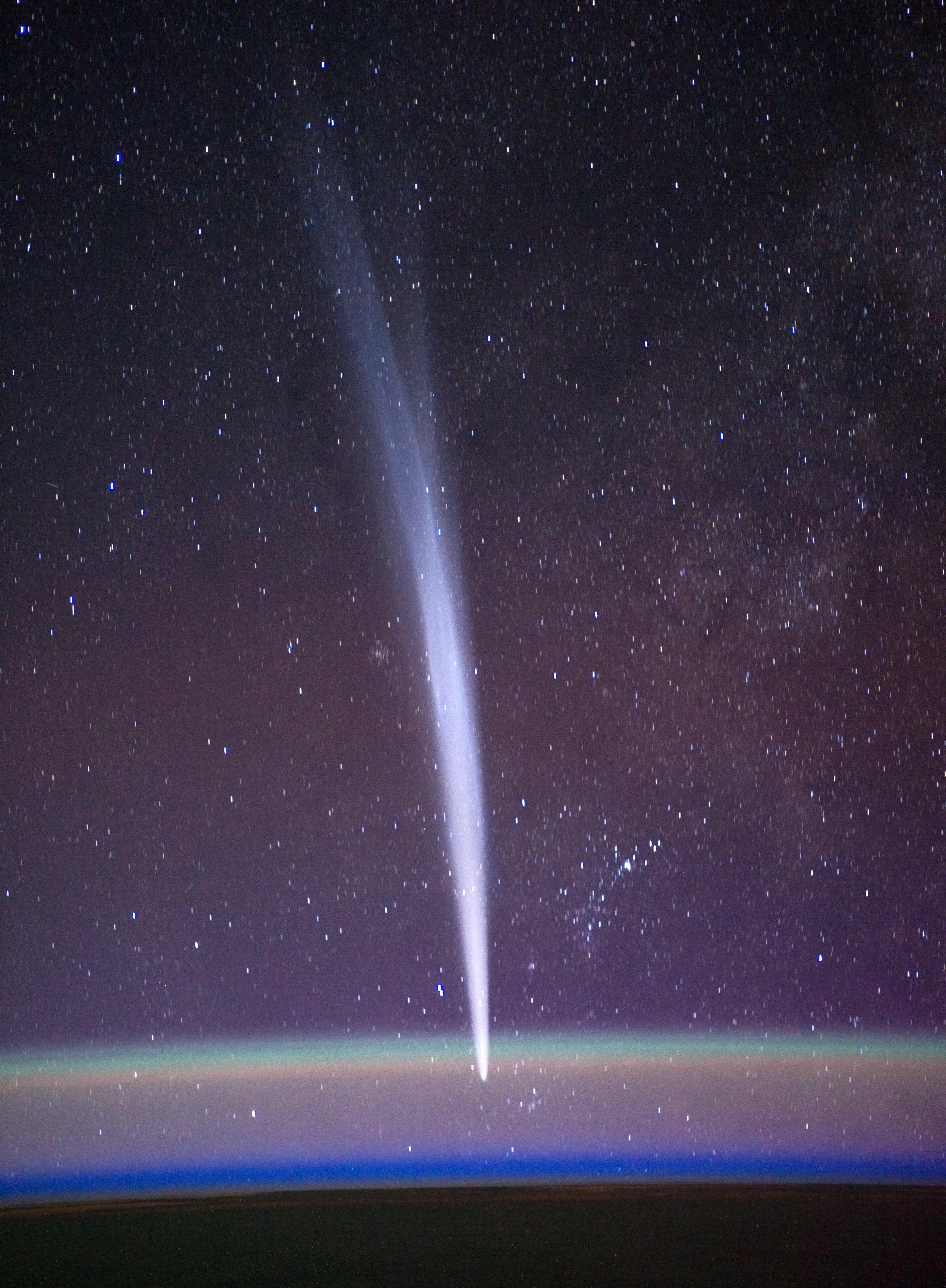
C/2011 W3 (Lovejoy) photographed from the ISS
Credit: By NASA/Dan Burbank
(25 Oct 2024) On 27 September 2024, the ATLAS project discovered a new comet relatively near the sun in the sky. Initial orbit computations at the MPC indicated this new discovery was a Kreutz Sungrazer - a very rare type of comet that comes so close to the sun at perihelion that some actually 'graze' the observed surface or photosphere.
Nearly all comets are completely unrelated, coming from random directions in the solar system and not sharing similar orbits with each other. However, sungrazers are all related - and are all thought to have come from a single, large comet that broke up near the sun at a previous passage. Human history is full of observations of these comets - from C/2011 W3 (Lovejoy), Ikeya-Seki in 1965, all the way back to 'Great Comets' in 1887, 1882, 1843, 1103 and some even earlier. (These comets are named generically after Heinrich Kreutz who identified them as coming from the same general orbit in a publication in 1888). Some of these historical sungrazers were extremely bright when very near the sun, including some visible in broad daylight by simply obscuring the sun with your hand. C/2011 W3 was a beautifully-photographed comet (right). There are also hundreds of very small sungrazers, not ever seen from the ground, visible in coronagraph imagery over the last 40 years or so. Sadly for us cometophiles, it appears C/2024 S1 is on the small side and may not survive perihelion or appear as a bright object in the sky during the first week of November. We won't know for sure until after perihelion (28 October), but keeping an eye on coronagraph images may give us some clues.
Sungrazers are exciting comets for researchers, even if the objects never become bright naked-eye objects. A number of NEO surveys that cover twilight, like ATLAS, have discovered sungrazing comets, but by far, the largest number of sun-grazing comets have been discovered from sunward-looking spacecraft, specifically the Solar and Heliospheric Observatory (cf. Battams and Knight, 2017; Bauer et al. 2024). With such close passage to the sun, comet materials are vaporized or sublimated at high rates, and often expose cometary materials we would not otherwise discover. Even the comets that fully disintegrate provide us with good science. Here's to hoping we learn a bit more about sungrazers, and comets in general, from the appearance of C/2024 S1.
References
- Battams, K., Knight, M. M. 2017. SOHO comets: 20 years and 3000 objects later. Philosophical Transactions of the Royal Society of London Series A 375. doi:10.1098/rsta.2016.0257
- Bauer J. M., Fernández Y. R., Protopapa S., and Woodney L. M. (2024) Comet science with groundbased and spacebased surveys in the new millennium. In Comets III (K. J. Meech, M. R. Combi, D. Bockelée-Morvan, S. N. Raymond, and M. E. Zolensky, eds.). In Press. Univ. of Arizona, Tucson.
C/2023 A3 Tsuchinshan-ATLAS

The comet, bright enough to be seen from the Washington DC metro region. Taken on Tue Oct 15, 7:36pm ET (23:26 UTC) using an Apple iPhone 14 (f/1.5, 1s, 5.7mm, ISO2500)
Credit: Tony Farnham
(10 October 2024) A bright comet, discovered in early 2023 jointly by the Purple Mountain Observatory & ATLAS teams, is currently in the news as it rounds the sun transitioning from a bright morning object visible to southern hemisphere observers in late September to a bright object in the evening evening sky starting the second week of October and persisting throughout the remainder of the month.
C/2023 A3 was discovered as part of the worldwide coordinated effort to find Near-Earth Objects (NEOs). Survey teams scan the sky every night for moving objects, and report these objects to the Minor Planet Center. C/2023 A3 was faint and far from the sun when discovered, and eventually located on other survey frames as far back as early 2022. A long observational arc such as this allows precise orbit computations and predictions far in the future. As such it was known at the time of discovery that the object was technically an NEO (perihelion < 1.3 AU). Comets are notoriously unpredictable in brightness, and in this case the comet has exceeded initial expectations and should be visible to the naked eye for northern hemisphere hemisphere observers from around 11 October through perhaps 25 October. While NEO surveys in recent years have discovered the majority of NEAs, with the possible exception of sun-grazing comets, they also discover the majority of comets in our nighttime skies.
While the object was near the sun in the sky (7-14 Oct), it could be safely observed online from the LASCO Coronagraph.
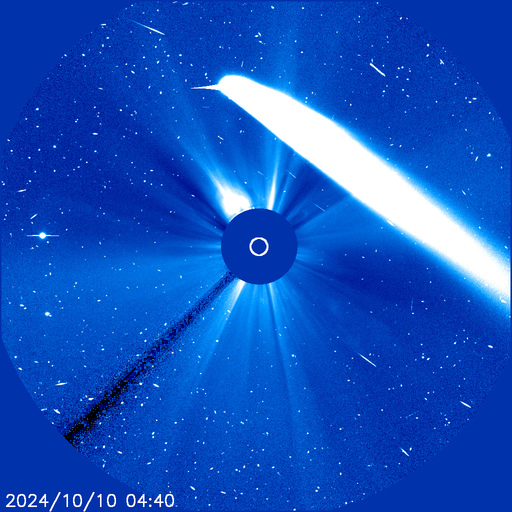
Comet Tsuchinshan-ATLAS as viewed in LASCO C3.
Credit: SOHO/LASCO
2023 BU: A record close-approaching small asteroid
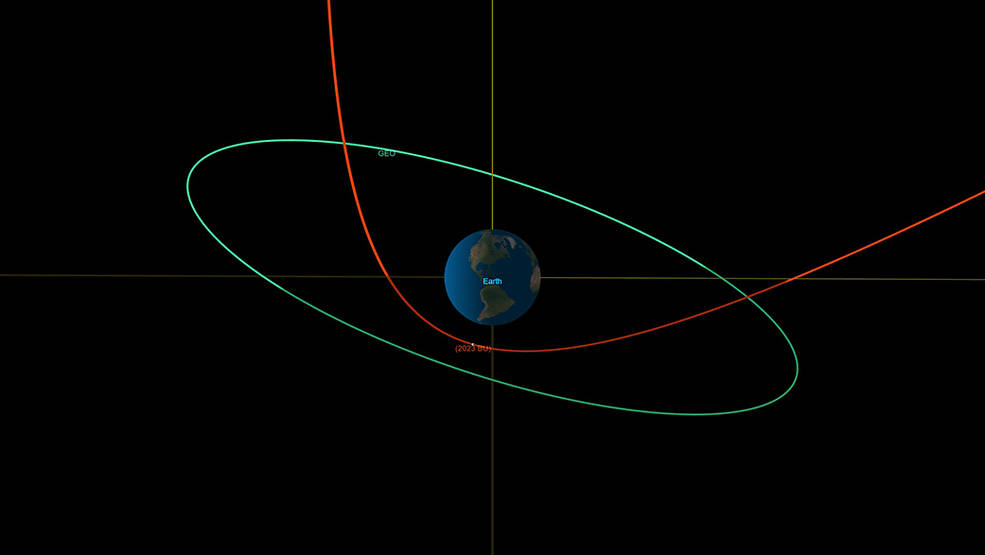
This orbital diagram from CNEOS' close approach viewer shows 2023 BU's trajectory (red) during its close approach with Earth on Jan. 26, 2023. The asteroid passed about 10 times closer to Earth than the orbit of geosynchronous satellites (green).
Credit: NASA/JPL-Caltech
(27 January 2023) On January 21, Gennady Borisov (discoverer of interstellar comet 2/I) discovered a small asteroid rapidly approaching the Earth. He promptly reported the object to the Minor Planet Center for posting on the Near-Earth Object Confirmation Page. After extensive follow-up observations and analysis by JPL's Scout: NEOCP Hazard Assessment page, it was clear that 2023 BU would pass < 4000 km from the surface of the Earth a few days later. More detailed write-ups are available from NASA and the Virtual Telescope Project. It is important to note that amateur astronomers such as Mr. Borisov can still make major contributions to discovery and monitoring of NEOs.
Brightening New Comet C/2020 F3 (NEOWISE)
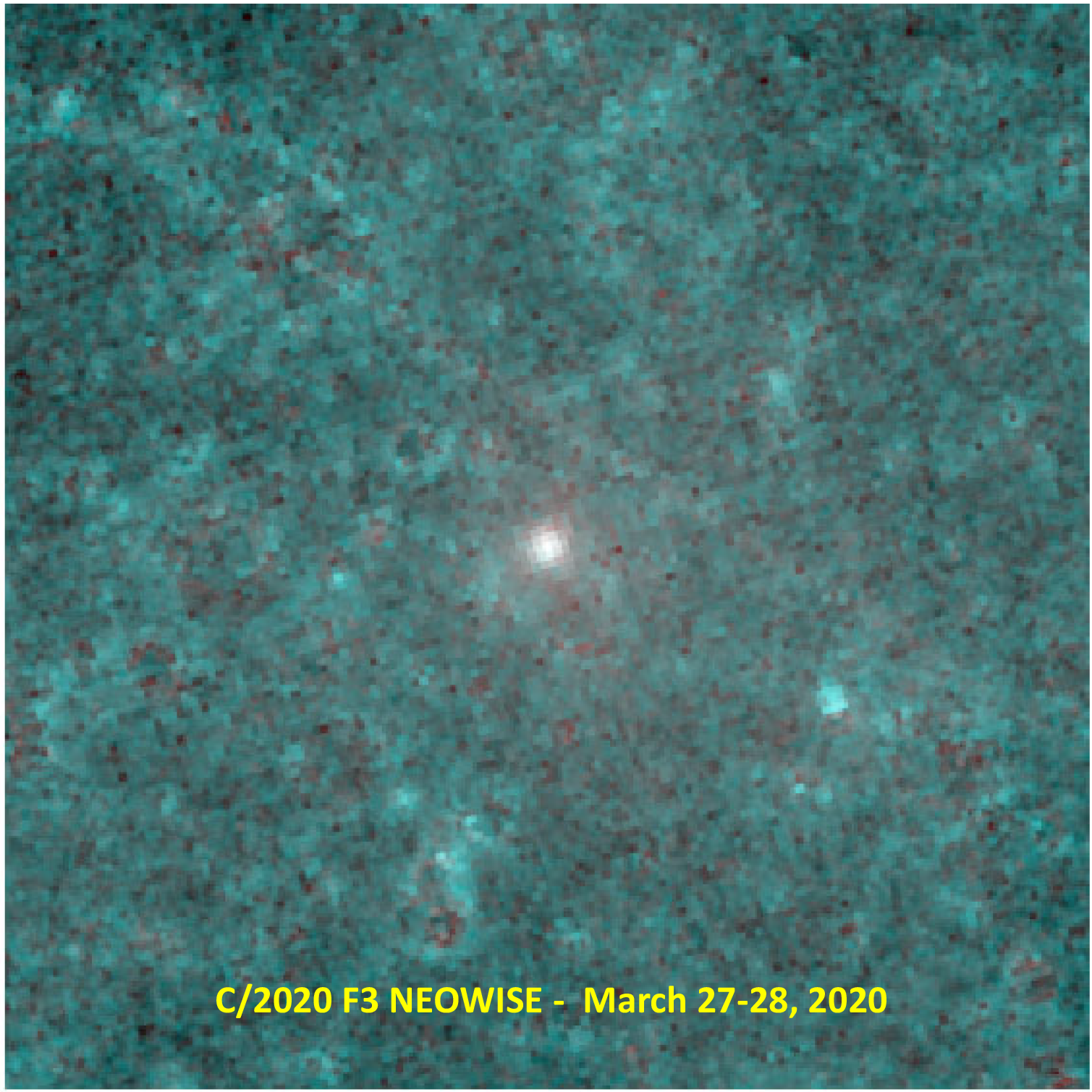
A stack of 13 NEOWISE exposures taken March 27 and 28, 2020 centered on the comet C/2020 F3 (NEOWISE), six arcminutes on a side and oriented with North up and East to the left. In this 3-color image, the 3.4 micron channel is mapped to the blue and green channels, while the NEOWISE 4.6 micron channel is mapped to red. The stack was taken when the comet was at a distance of 2.1 AU from the sun and 1.7 AU from the earth.
Credit: NEOWISE/NASA/JPL
(08 July 2020) Astronomers and stargazers on the Earth now have a decently bright comet to see. A new comet, C/2020 F3 (NEOWISE), has just passed perihelion (its closest point to the Sun) on July 3, and will soon appear in the evening sky in the coming weeks -- providing that it doesn't fall apart.
Comet NEOWISE was discovered by NASA's Near-Earth Object Wide-field Infrared Survey Explorer (NEOWISE) spacecraft on March 27, 2020. At the time of the discovery, it was at a very modest 17th magnitude, or 20,000 times fainter than the faintest star visible to naked-eye. However, after follow-up observations by observers worldwide, astronomers soon realized that Comet NEOWISE -- now bearing the discoverer's name -- is on a somewhat unique orbit, passing at 0.3 astronomical units from the Sun which is inside Mercury's orbit.
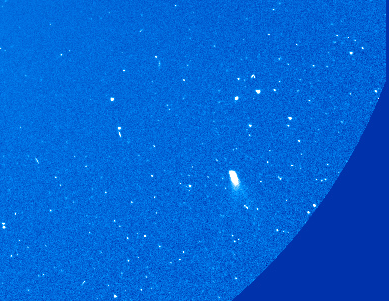
C/2020 F3 (NEOWISE) in the SOHO field taken on 2020 June 25. SOHO is a project of international cooperation between ESA and NASA.
Credit: SOHO/NASA/ESA
The spacecraft of NASA's NEOWISE mission follows a pole-to-pole orbit near the Earth's day/night boundary. The telescope faces outward, away from the Earth, taking exposures of the sky at infrared wavelengths every 11 seconds, completing roughly two passes of the sky each year. The simple, robust design of the mission has allowed the spacecraft to continue operations into its second decade since its launch.
NEOWISE's remarkable capability in discovering dark Near-Earth Asteroids and characterizing tens of thousands of asteroids is well known, but few may know that it is also a very successful comet hunter, having discovered 33 comets since 2010. The new comet was first detected by NEOWISE in the deep southern sky, where the coverage by the current ground-based survey network is relatively sparse. As a space-based platform, NEOWISE is not subjected to geographic limitations and thus is able to cover both northern and southern skies equally well, as attested by the discovery of the new comet.
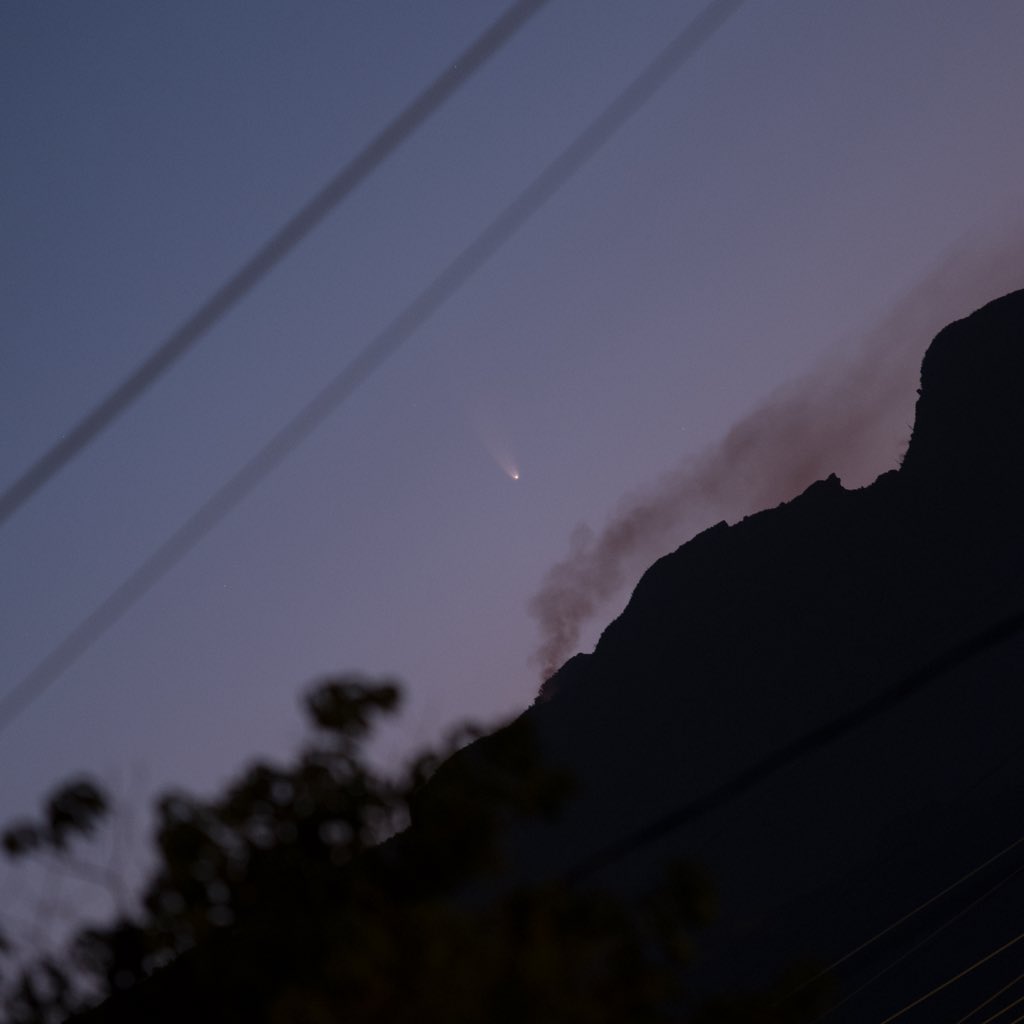
Comet NEOWISE in the morning of 2020 July 4.
Credit: Yujing Qin (University of Arizona)
Since the official announcement of discovery by the Minor Planet Center, astronomers have been carefully following the development of Comet NEOWISE. It reached 6th magnitude by mid June shortly before disappearing into the Sun's glare as viewed from Earth. The NASA/ESA Solar and Heliospheric Observatory (SOHO), a space-based solar observatory that monitors the Sun and the sky around it, picked up the baton and followed the comet until June 28. Astronomers delightedly noticed that Comet NEOWISE had brightened to 2nd magnitude in SOHO images, in par with the brightness of Polaris, making it one of the brightest comets since Comet ISON in 2013.
Comet NEOWISE has just reemerged from the Sun's glare and has been recovered by ground-based observers. Currently the comet is low in the morning sky at about 1st magnitude, with a tail that is a couple degrees long. It will continue to recede from the Sun, and will become visible in the evening sky after mid-July. Comets are notoriously difficult to predict, but if all goes as predicted, we will have a decently bright comet in the evening sky to enjoy in the next couple weeks.
- Tweet from AsteroidWatch
- Comet NEOWISE Sizzles as It Slides by the Sun, Providing a Treat for Observers
ZTF Discovers a New Class of Solar System Object: 2020 AV2

Graphic showing orbit of 2020 AV2. It is between the orbits of Venus and Mercury and inclined relative to the Earth's orbit.
Credit: JPL Small-Body Database Browser
(09 January 2020) On 4 January, 2020, the Zwicky Transient Facility team discovered a new fast-moving object and reported it immediately to the Minor Planet Center (MPC). Once posted on the MPC's NEO Confirmation Page, other observers from around the world measured the object's position on the sky. These measurements facilitated a precise fit to the object's fascinating orbit. The orbital path of 2020 AV2 resides entirely between Venus and Mercury (MPC orbital diagram), and does not cross the orbits of either of those planets. The size of 2020 AV2 is likely between about 1 and 3 km in diameter. Currently 2020 AV2 has both the smallest semi-major axis and smallest aphelion of any known asteroid. An orbit such as this renders 2020 AV2 extremely difficult to detect from ground based optical telescopes. The object's closest possible approach to the Earth is ~0.35 AU, over 11 million km further than Venus' closest distance from Earth!!
New Interstellar Visitor to the Solar System: Comet 2I/(Borisov)
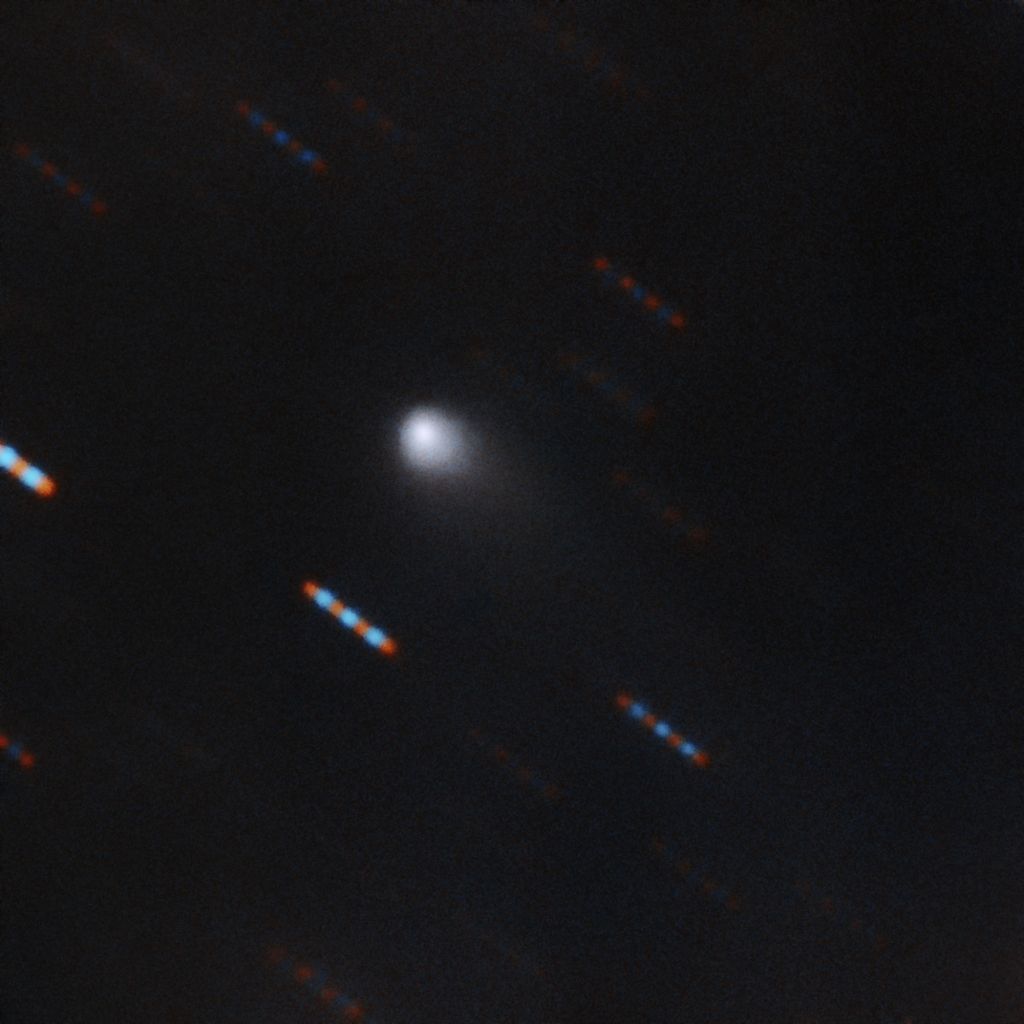
Two-color composite image of C/2019 Q4 (Borisov) obtained using the Gemini North Multi-Object Spectrograph (GMOS) from Hawaii's Maunakea. Four 60-second exposures in bands (filters) r and g (but colored as red and blue) stacked on the comet such that background stars appear to streak due to the motion of the comet.
Credit: Gemini Observatory/NSF/AURA/Travis Rector
(29 September 2019) On the morning of 30 August, 2019, Gennady Borisov, of Nauchny, Crimea, discovered a new comet. At the time of discovery, the object seemed to be a typical comet-it was discovered when observing near the sun in the morning sky and sported a small tail. Gennady dutifully re-observed the object the following night, and by this point it was posted on the Minor Planet Center's Possible Comet Confirmation Page such that other observers worldwide could observe the object.
As additional worldwide observations flowed to the MPC, it became clear the comet was on an unusual orbit, and early calculations by various orbit computers worldwide suggested the object might be unbound to our solar system. The object was formally announced on 11 September with a confirmed interstellar trajectory.
While not technically an NEO, C/2019 Q4 (Borisov) is of great interest to astronomers worldwide, and presents a heretofore rare opportunity to study a population which regularly passes through Earth's solar system. Careful observations over the next few months will allow astronomers to determine some of the molecules and elements that make up the comet's coma and perhaps even study the nucleus directly. These data can be compared with what we know about the comets in our own Solar System and differences will provide information on the formation environment of this object and thus its natal system. This is only the second ever known interstellar visitor (the other being 1I/`Oumuamua), and we have much to learn about these denizens of the galaxy.
The discovery of this object once again demonstrates that valuable, and even historic discoveries can be made by the world's amateur astronomers. Comet 2I/(Borisov) was first detected using a telescope constructed and assembled by the discoverer.
Asteroid 2019 MO: The Latest Confirmed Small Impactor
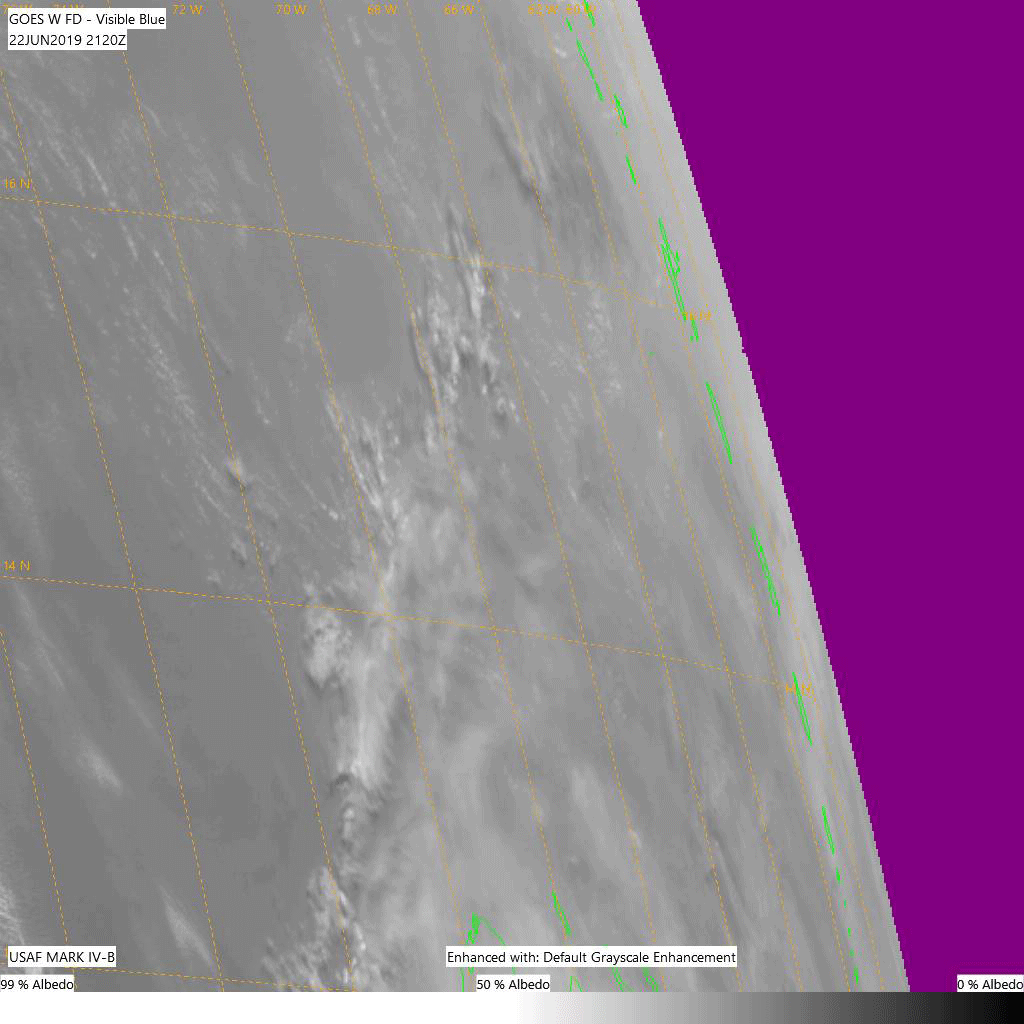
GOES West weather imagery showing the condensation trail from the entry of 2019 MO through the atmosphere and the trail's shadow on the cloud tops.
Credit: NOAA
(25 June 2019) On the night of 21/22 June, 2019, the ATLAS team detected a possible new NEO, which they attached the temporary designation A10eoM1. As is typical, the position measurements of the object were sent to the Minor Planet Center and posted immediately on the NEO Confirmation Page so that worldwide observers might provide additional measurements on the object.
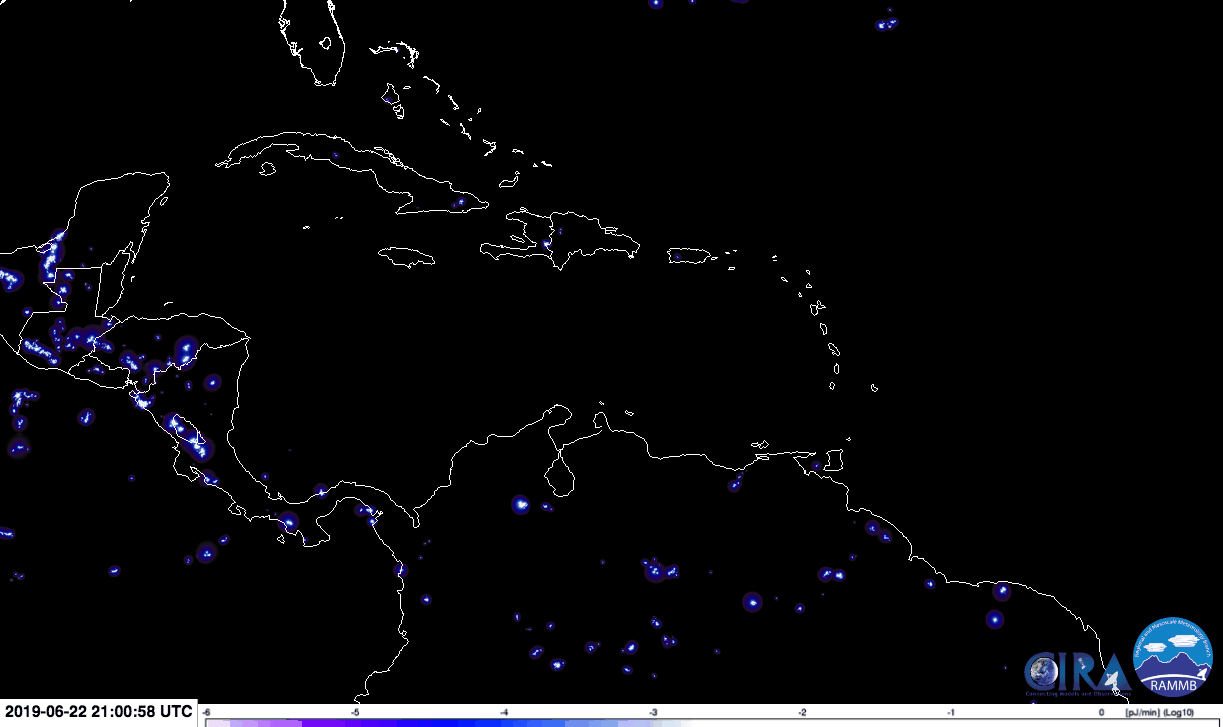
Impact flash from 2019MO detected by Geostationary Lightning Mapper (GLM) instrument on GOES-R.
Credit: NOAA
In what appeared at first to be an unrelated event, Dwayne Free (director of the Spalding AllSky Camera network noticed a possible impact in the GOES Geostationary Lighting Monitor (GLM) data that indicated an atmospheric entry somewhere in the Caribbean region.
Once he was aware of this impact, Davide Farnocchia of JPL's Center for NEO Studies gave a good look at the CNEOS Scout Alert list to see if any newly-discovered NEOs might link to this recent event, and he was able to suggest that the Caribbean impact and A10eoM1 might be the same object. Once he was armed with the additional data (which were really just a rough time and location for the impact!), Farnocchia tentatively linked the two events and produced a new orbit calculation. With this updated orbit, Rob Weryk and Mark Huber of the University of Hawai'i and the Pan-STARRS project found additional data of the object. Marco Micheli then performed high-precision astrometry on the data, which were obtained a few hours before the ATLAS discovery observations. With all of the data on hand, a precise orbit could be computed that confirmed the impact time and location, and also indicated the object was around 5 meters in diameter. The Minor Planet Center has designated the object and published the observations.
The Earth is impacted several times per year by objects of this size. While NASA surveys are specifically tasked with finding much larger objects, the success of the system as a whole is demonstrated by the ability to find and identify these small, yet frequent, impactors.
Bering Sea Bolide
(18 Mar 2019) On 18 December 2018, infrasound sensors (originally put in place to detect nuclear explosions) detected an airburst from a previously undetected NEO. The object exploded harmlessly at around 26 km above the Earth's surface. Data on these events are provided to NASA after they are determined to be natural events and cleared for public release. While impacts of this type occur fairly regularly, the impacting energy was on the large side at around 1/3 the energy of the Chelyabinsk impactor. By tabulating each impact's energy, we can estimate the flux of impactors in a given energy and very roughly extrapolate to the total population of objects in this size range. Current population estimates suggested fewer objects in this size range, so there may in fact be a larger population of small (< 20 meter) impactors than previously thought. Keeping track of future impacts of this size is one way to answer this question.
From an IAWN communication perspective, this impactor was important. The geographic location of this impact is in an area with some moderate geopolitical nuclear tension. Several notable planetary scientists in the past (such as Carl Sagan) have worried that impacts of small asteroids could be mistaken for nuclear explosions. Thankfully, in real time the infrasound detectors indicated this was unlikely to be a nuclear explosion and more likely a natural event.
Update on Cuban Bolide
(04 Feb 2019) At around 1:15 PM local time on Friday, 1 February 2019, a small asteroid entered the atmosphere over Cuba and exploded harmlessly at an altitude of around 40 km. The entry was picked up by the Geostationary Lightning Mapper instrument on GOES weather satellites, and the explosion was detected by the infrasound network (used to warn of nuclear explosions). The meteor and subsequent shock wave were also reported by locals on the ground in the Pinar del Río Province of Cuba.
As of this writing (around noon UTC, Monday 4 February) there is little information on the trajectory. Rough estimates suggest the object was only a few meters in size, rendering it undetectable by current ground-based assets until it was a few hours from impact had it been in the nighttime sky. Objects this size hit the Earth several times per year, often over ocean, and on two occasions were tracked all the way to the ground, allowing collection of meteorites.
Mapping the trajectories and recovering meteorites allows scientists to learn about the origin and evolution of the NEO population as a whole. Each of these events adds another piece to the scientific puzzle.
- Infrasound detection, via P. Brown
- ~2 min video from a local showing the train and then the shock wave
- Summary from American Meteor Society
- Twitter reports (#Vinales #meteor)
Bolide Over Cuba
(02 Feb 2019) Bolide witnessed over Cuba, fragments reported as recovered. AMS: Meteorite hits Cuba with huge sonic boom
2018 LA - The Discovery of Another Very Small Impacting NEO
(4 Jun 2018) Richard Kowalski of The Catalina Sky Survey (CSS) has discovered yet another small (2-4 meter diameter) NEO just hours before it exploded harmlessly in the atmosphere above the southern regions of Africa. Detailed articles:
- JPL press release: Tiny Asteroid Discovered Saturday Disintegrates Hours Later Over Southern Africa
- MPC's discovery MPEC for 2018 LA
- AMS article: Asteroid spotted hours before impact with atmosphere over Botswana
Expect this object to be discussed further in the near future on these pages.
MPECs and Announcing Discoveries to the World
(4 Jun 2018) In the next few weeks, a series of articles will appear here to discuss NEO discovery, the NEO Confirmation Page, orbital improvement, announcement, close approaches, and communication. The goal will be to provide the reader general background information on the day-to-day operation of the IAWN. The first piece in this group will discuss announcing NEO discoveries.
New NEOs are announced to the world via the Minor Planet Center (MPC's) Circulars - in this case Minor Planet Electronic Circulars or MPECs. Each MPEC has a standard header and format, but each circular is unique in that it pertains to a different object to be announced. As an example, we will discuss the discovery announcement of 2018 KB3: www.minorplanetcenter.net/mpec/K18/K18KA1.html
At the top of each MPEC is the standard header providing some information on the MPC, contact information, and so on. Below this is the object designation (2018 KB3) followed by the observations in the standard format. Specified within the observation string is the exact time of each observation, the precise sky coordinates (in right ascension and declination), followed by the brightness of the object and finally the reference and reference location on the globe as indicated by the 3-character Observatory Code.
Below the observation block are specific observer details - showing which telescopes observed the object, and which observers took part in these observations. Further, there is information on the size and type of each telescope listed here.
Next follows the full orbital element set for each object. The orbital elements are used to project the location of the object, either in the past or future, to assist in searching for past observations or planning future observing. The orbital elements also allow the computation of the Earth MOID, which is the minimum distance between the orbit of the Earth and the current orbit of the object. MOIDs are useful for helping observers select which NEOs to target for future observations. In this case, a MOID of > 0.3 Astronomical Units (around 35 million miles) indicates that 2018 KB3 is not a threat to the Earth for the foreseeable future.
Beneath the orbital elements is what is called a residual block; this shows how well the observations published in this MPEC match the orbit the MPC computed. These residuals are all in *arcseconds*, or 1/3600 of a degree, for each right ascension and declination. These small numbers will indicate to those not familiar with observations just how precise NEO measurements are these days.
At the bottom of each MPEC is an ephemeris, or a list of future positions on the sky for 2018 KB3. It is placed here to assist observers in planning future observations of this object, if necessary. NEOs can appear just about anywhere in the sky, and change brightness rapidly, so the specifics of each object help guide observing planning.
With this as a general backdrop for interpreting an individual MPEC, the reader should know that last year (2017) the MPC issued over 2000 discovery MPECs! The message here is that NEO discoveries are made more or less daily, and most are entirely routine. Readers that wish to track the pace of discoveries, or simply browse all MPECs, can follow the two links below:
+ NEO Discovery Table: www.minorplanetcenter.net/iau/lists/YearlyBreakdown.html
+ Recent MPEC page: www.minorplanetcenter.net/mpec/RecentMPECs.html
2018 JB3 - The New Discovery of a Rare Atira-Class of NEO
(May 2018) On May 13, Richard Kowalski of the Catalina Sky Survey reported the discovery of a bright minor planet at the relatively small solar elongation of ~55 degrees. Astrometric follow-up from Tautenburg (033), Spacewatch II (291), Slooh Observatory, Canary Islands (G40), Great Shefford (J95), JAXA Space Tracking and Communications Center (P93); as well as prediscovery images from Palomar Mountain/ZTF (I41) allowed the MPC to perform precise orbital calculations.
As this Circular notes, 2018 JB3 has a trajectory that keeps the object closer to the Sun than the Earth at all times! This makes 2018 JB3 a special class of NEO - an Atira or Apohele object. This is only the 30th discovery of an object in this class.
The astute reader may wonder why we would be concerned about such objects from a threat perspective. After all, the orbit of this object fits snugly between the Earth and Sun, posing no immediate threat. While this is true, we do have several science and hazard-driven goals in studying such populations. First, this population is almost completely unknown. With only 30 discoveries, it is abundantly clear these are exceedingly difficult objects to discover from the ground and at the moment we really do not know how large the population might be. Second, objects on trajectories such as these are often unstable on 100-year timeframes, and minor changes to the orbit could render these objects potential impactors. Lastly, and perhaps most importantly, even among the 30 known objects in this class, there are a few that approach the Earth closely. Given the nature of the orbits, Atira objects often spend a lot of time in the vicinity of the Earth. This fact can render these objects a bit more likely to impact the Earth than other NEOs on an object-by-object basis. For a glance at the orbit of this object, readers may look at either the Minor Planet Center page or the JPL Center for NEO Studies page for this object. For a bit of background on early searches objects at small solar elongations, see research by David Tholen and Rob Whiteley from the late 1990s.